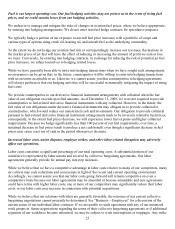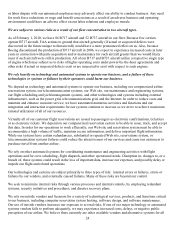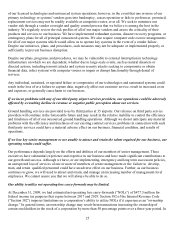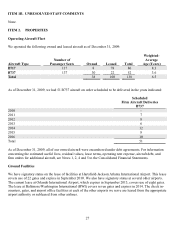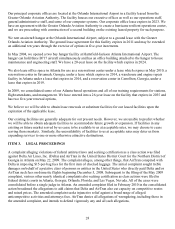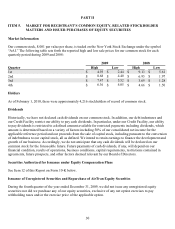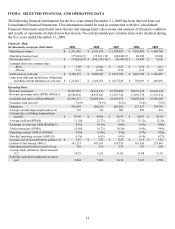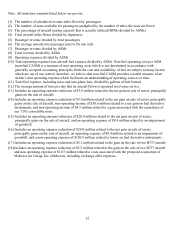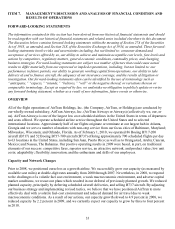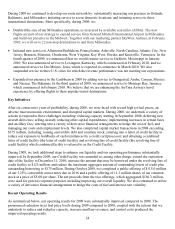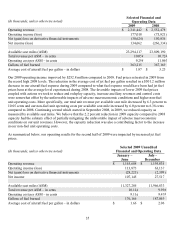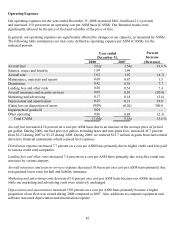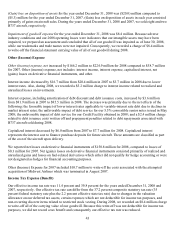Airtran 2009 Annual Report Download - page 42
Download and view the complete annual report
Please find page 42 of the 2009 Airtran annual report below. You can navigate through the pages in the report by either clicking on the pages listed below, or by using the keyword search tool below to find specific information within the annual report.33
ITEM 7. MANAGEMENT’S DISCUSSION AND ANALYSIS OF FINANCIAL CONDITION AND
RESULTS OF OPERATIONS
FORWARD-LOOKING STATEMENTS
The information contained in this section has been derived from our historical financial statements and should
be read together with our historical financial statements and related notes included elsewhere in this document.
The discussion below contains forward-looking statements within the meaning of Section 27A of the Securities
Act of 1933, as amended, and Section 21E of the Securities Exchange Act of 1934, as amended. These forward-
looking statements involve risks and uncertainties including, but not limited to: consumer demand and
acceptance of services offered by us, our ability to achieve and maintain acceptable cost levels, fare levels and
actions by competitors, regulatory matters, general economic conditions, commodity prices, and changing
business strategies. Forward-looking statements are subject to a number of factors that could cause actual
results to differ materially from our expressed or implied expectations, including, but not limited to: our
performance in future periods, our ability to generate working capital from operations, our ability to take
delivery of and to finance aircraft, the adequacy of our insurance coverage, and the results of litigation or
investigation. Our forward-looking statements often can be identified by the use of terminology such as
“anticipates,” “expects,” “intends,” “believes,” “will” or the negative thereof, or variations thereon or
comparable terminology. Except as required by law, we undertake no obligation to publicly update or revise
any forward-looking statement, whether as a result of new information, future events or otherwise.
OVERVIEW
All of the flight operations of AirTran Holdings, Inc. (the Company, AirTran, or Holdings) are conducted by
our wholly-owned subsidiary, AirTran Airways, Inc. (AirTran Airways or Airways) (collectively we, our, or
us). AirTran Airways is one of the largest low cost scheduled airlines in the United States in terms of departures
and seats offered. We operate scheduled airline service throughout the United States and to selected
international locations. Approximately half of our flights originate or terminate at our largest hub in Atlanta,
Georgia and we serve a number of markets with non-stop service from our focus cities of Baltimore, Maryland;
Milwaukee, Wisconsin; and Orlando, Florida. As of February 1, 2010, we operated 86 Boeing B717-200
aircraft (B717) and 52 Boeing B737-700 aircraft (B737) offering approximately 700 scheduled flights per day
to 63 locations in the United States, including San Juan, Puerto Rico; as well as to Orangestad, Aruba; Cancun,
Mexico; and Nassau, The Bahamas. Our positive operating results in 2009 were based, in part, on traditional
elements of our success: competitive fares, superior service, an attractive network, and product value; low unit
costs; adaptability; flexibility; innovation; and the enthusiasm and skills of our employees.
Capacity and Network Changes
Prior to 2008, we positioned ourselves as a growth airline. We successfully grew our capacity (as measured by
available seat miles) at double-digit rates annually from 2000 through 2007. Nevertheless, in 2008, to respond
to the challenges of a volatile fuel cost environment, a weak macroeconomic environment, and adverse capital
market conditions, we recast our plans which resulted in our deferral of previously planned growth. We reduced
planned capacity, principally by deferring scheduled aircraft deliveries, and selling B737 aircraft. By adjusting
our business strategy and implementing revised tactics, we believe that we have positioned AirTran to more
effectively deal with a volatile fuel-cost environment and reduced demand for air travel due to weak
macroeconomic conditions. As a result of our actions, our capacity growth slowed to 4.9 percent in 2008, we
reduced capacity by 2.2 percent in 2009, and we currently expect our capacity to grow by three to four percent
in 2010.


